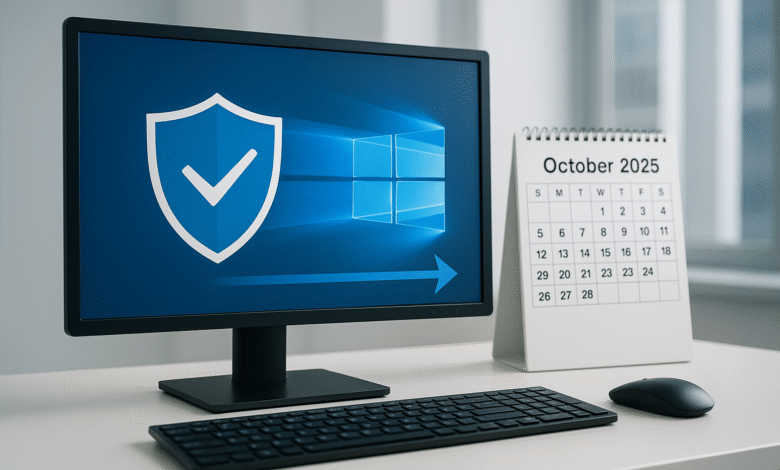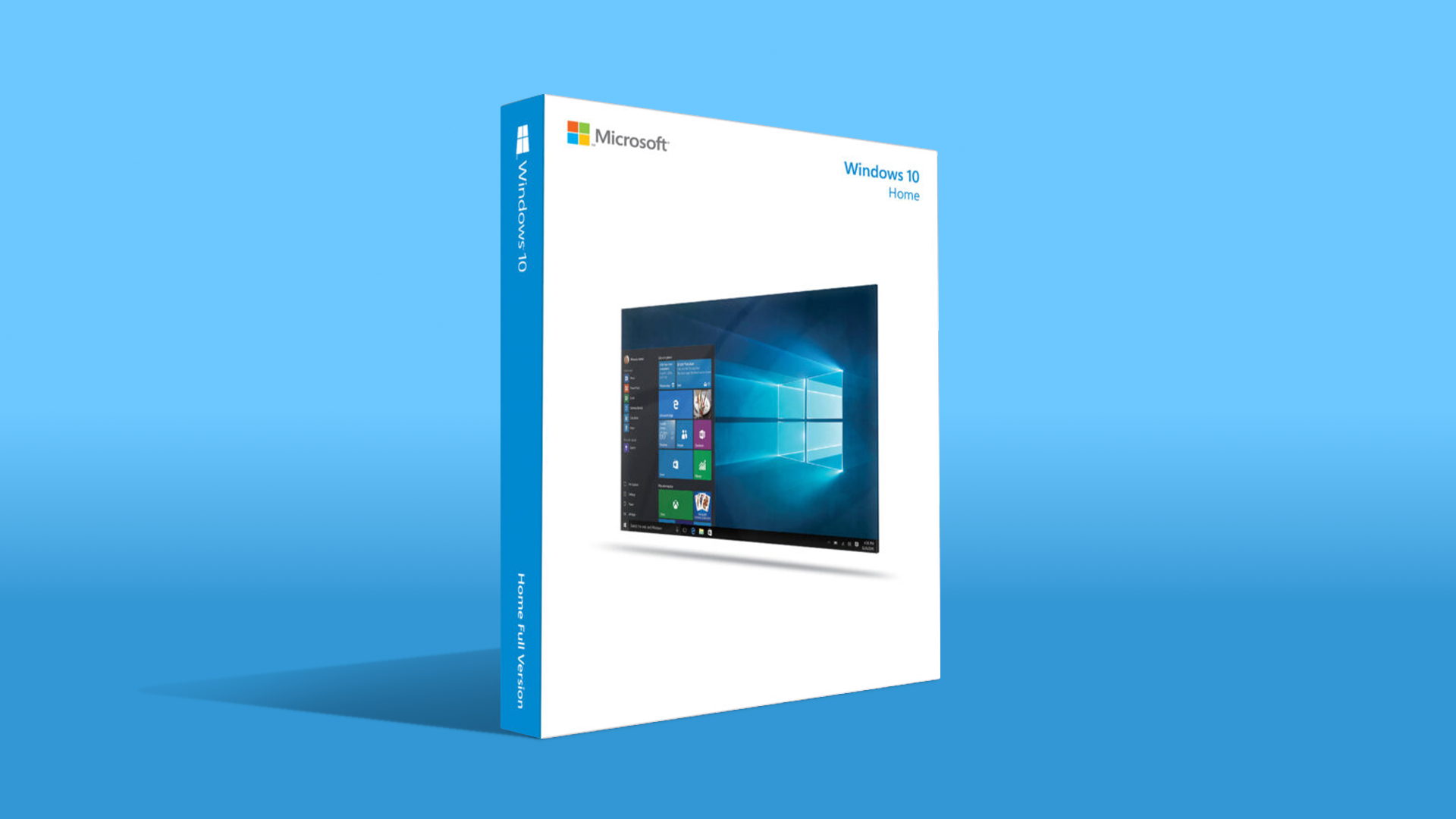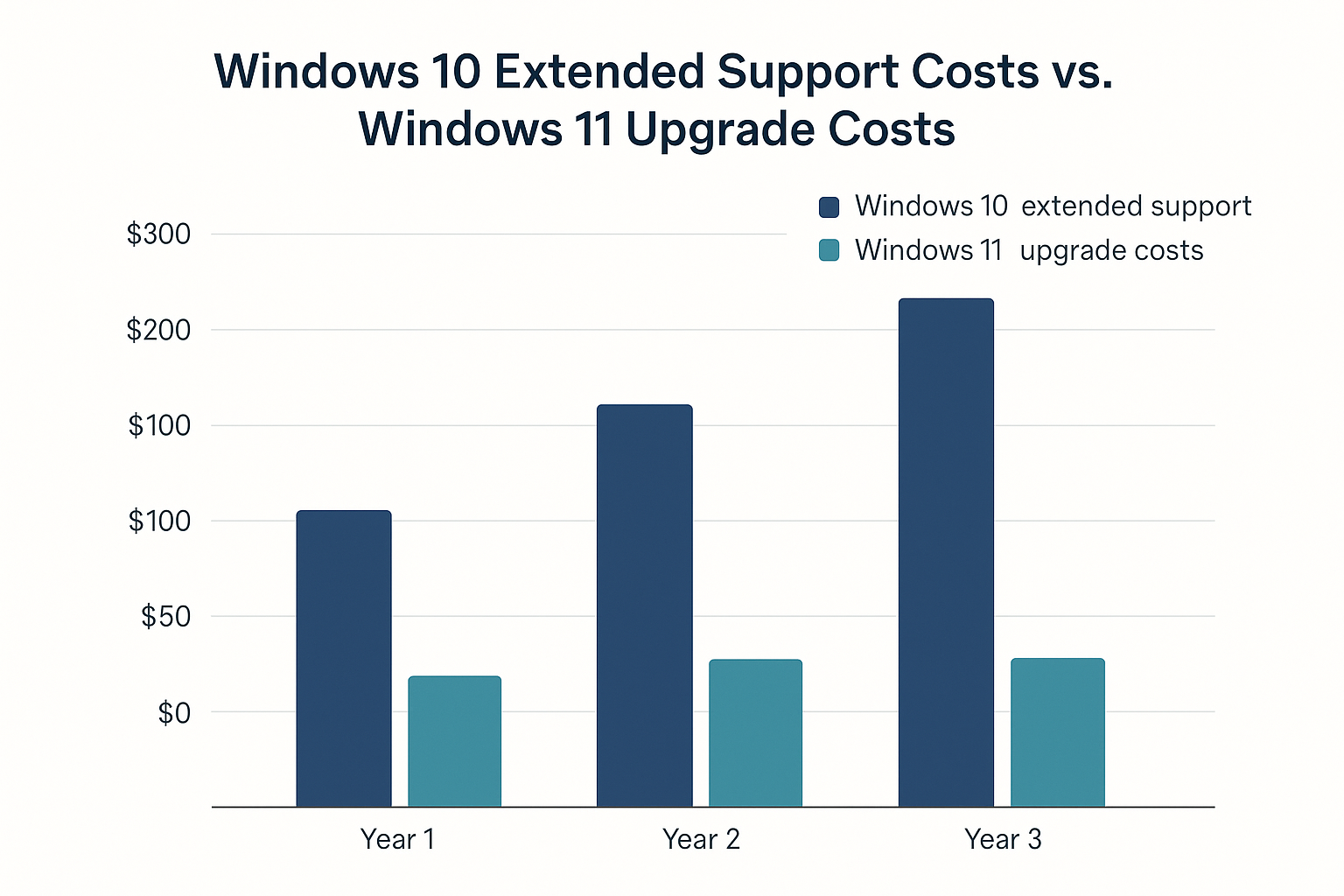How to Get Windows 10 Extended Support: Step-by-Step 2025 Guide
Get Windows 10 extended support after Oct 2025. Learn costs, setup steps, alternatives & keep your systems secure beyond end-of-life. Complete guide.

As Microsoft’s Windows 10 end-of-support date of October 14, 2025 approaches, millions of users and organizations face a critical decision that could impact cybersecurity, compliance, and business continuity. One of the most searched questions today is: What is Windows 10 Extended Support, and how do you enable it?
This guide explains everything you need to know about Microsoft’s Extended Security Updates (ESU) program—from eligibility and costs to step-by-step activation—so you can maintain essential protection while planning your long-term IT strategy.
What is Windows 10 extended support
What is Windows 10 extended support becomes a critical question as millions of users face an important decision about their operating system’s future. Extended support represents Microsoft’s paid service that provides continued security patches and critical updates beyond the standard support lifecycle. This program ensures that organizations and users can maintain secure computing environments even after mainstream support concludes.
The significance of extended support extends far beyond simple software maintenance. For businesses running legacy applications, specialized hardware, or complex IT infrastructures, immediate migration to newer operating systems may prove impractical or prohibitively expensive. Extended Security Updates (ESU) bridge this gap, offering a structured pathway to maintain security while planning strategic transitions.
Microsoft’s end-of-support timeline for Windows 10 (October 2025)
Microsoft has established the Windows 10 end of support date as October 14, 2025, marking the conclusion of mainstream support for this widely-adopted operating system. This Windows 10 end of life 2025 timeline represents the final phase of the Windows 10 support lifecycle, after which regular security updates, bug fixes, and technical support will cease for most users.
The Windows 10 support lifecycle follows Microsoft’s established pattern of providing ten years of support from the initial release date. Since Windows 10 launched in July 2015, the October 2025 deadline represents the natural conclusion of this cycle. Understanding this timeline is crucial for planning migration strategies or evaluating extended support options.
Who needs Extended Security Updates (ESUs)
Microsoft extended security updates for Windows 10 target specific user categories who cannot immediately transition to newer operating systems. Enterprise organizations with complex IT environments, healthcare facilities managing specialized medical equipment, manufacturing companies running proprietary software, and educational institutions with budget constraints represent primary candidates for extended support.
Small and medium businesses often find themselves in situations where Windows 10 upgrade vs extended support becomes a strategic decision based on resource availability, application compatibility, and operational continuity requirements. Organizations must evaluate whether their current systems can support Windows 11’s hardware requirements or if extended support provides a more viable short-term solution.
II. Understanding Windows 10 Extended Support
Definition of Extended Security Updates (ESUs)
Windows 10 extended security updates (ESU) represent Microsoft’s commercial program designed to provide continued protection for systems that cannot immediately upgrade to supported operating systems. These updates focus exclusively on addressing security vulnerabilities and critical issues that could compromise system integrity or data protection.
The ESU program differs significantly from regular Windows updates by concentrating solely on security-related patches rather than feature enhancements or performance improvements. This targeted approach ensures that systems remain protected against emerging threats while maintaining operational stability for organizations requiring extended transition periods.
Difference between extended support and mainstream support
The difference between extended support and mainstream support lies primarily in scope, cost, and availability. Mainstream support includes regular feature updates, non-security fixes, design changes, and complimentary technical support through various channels. Extended support narrows this scope to security-only updates delivered through a paid subscription model.
During mainstream support, Microsoft provides comprehensive assistance including feature requests, warranty claims, and no-charge incident support. Extended support eliminates these services, focusing exclusively on vulnerability mitigation and critical security patches that protect against actively exploited threats.
What’s included: security updates vs. feature updates
Extended support packages include only essential security patches that address vulnerabilities identified by Microsoft’s security research team or reported through responsible disclosure programs. These updates target malware protection, system integrity, and data security without introducing new functionality or user interface changes.
Feature updates, design modifications, and performance enhancements remain excluded from extended support packages. Organizations choosing this path should expect their systems to maintain current functionality levels without receiving productivity improvements or user experience updates available in newer operating systems.
III. Eligibility Requirements
Volume licensing requirements
Windows 10 extended support license availability requires participation in Microsoft’s Volume Licensing program, excluding individual consumer purchases through retail channels. Organizations must maintain active Software Assurance or equivalent volume licensing agreements to qualify for ESU enrollment.
Eligible licensing programs include Enterprise Agreement (EA), Enterprise Agreement Subscription (EAS), Microsoft Customer Agreement (MCA), and Open Value Subscription. These programs ensure that organizations have established relationships with Microsoft and meet minimum purchase thresholds for extended support services.
Supported Windows 10 editions
Enable Windows 10 Pro extended updates requires specific edition compatibility, with support limited to Windows 10 Pro, Enterprise, and Education editions. Home edition users cannot access extended support services regardless of licensing arrangements or payment willingness.

This edition restriction reflects Microsoft’s strategic focus on business and institutional customers who typically require extended transition periods for complex IT environments. Organizations running mixed environments must ensure all systems operate on supported editions before ESU enrollment.
Hardware compatibility considerations
Hardware compatibility extends beyond Windows 10 requirements to include support for extended update delivery mechanisms and security patch installation processes. Systems must maintain network connectivity and sufficient storage space for ongoing security update downloads and installations.
Older hardware may experience challenges with newer security technologies integrated into extended updates. Organizations should conduct compatibility assessments to identify potential issues before committing to extended support subscriptions.
IV. How to Enable Windows 10 Extended Support
Step-by-Step Setup Process
How to enable Windows 10 extended support begins with purchasing appropriate licenses through Microsoft’s Volume Licensing Service Center or authorized partners. Organizations must first verify their eligibility status and determine the number of devices requiring extended support coverage.
Activate Windows 10 extended support involves installing Multiple Activation Keys (MAK) provided by Microsoft after ESU purchase completion. These keys enable extended update delivery and must be applied to each device requiring continued support coverage.
Enable Windows 10 extended support updates requires configuration through Group Policy or registry modifications that direct systems to Microsoft’s ESU update servers. This process ensures that devices receive security patches from the appropriate distribution channels during the extended support period.
Purchasing ESU licenses through Volume Licensing
The purchasing process involves working with Microsoft representatives or authorized partners to determine appropriate licensing quantities and subscription terms. Organizations must provide device inventories and specify coverage periods when requesting ESU quotes.
License activation requires administrative privileges on target systems and may involve coordination with Microsoft support teams for initial configuration. Organizations should plan implementation timelines that allow for testing and validation before mainstream support expires.
Technical Requirements
Systems require active internet connectivity for ESU update delivery, along with sufficient administrative permissions for patch installation processes. Windows Update services must function properly, and firewall configurations should allow communication with Microsoft’s update servers.
Storage requirements include adequate disk space for temporary update files and system restore points created during patch installation. Organizations should verify that backup and recovery procedures remain compatible with extended support update processes.
V. Cost Considerations
Pricing structure for ESU licenses
Windows 10 extended support cost follows a tiered pricing model that increases annually throughout the extended support period. First-year costs typically represent baseline pricing, with subsequent years featuring significant price increases designed to encourage migration to supported operating systems.
Extended support pricing for Windows 10 varies based on device edition, with Enterprise editions commanding premium pricing compared to Pro editions. Educational discounts may apply for qualifying institutions, while government pricing follows separate negotiation processes.
Cost comparison: ESU vs. Windows 11 upgrade

Buy Windows 10 extended support represents a temporary solution that organizations should evaluate against complete Windows 11 migration costs. While extended support provides immediate continuity, total costs over multi-year periods often exceed comprehensive upgrade investments.
Organizations must consider hardware replacement costs, application compatibility testing, user training requirements, and productivity impacts when comparing extended support against upgrade alternatives. Long-term total cost of ownership typically favors migration strategies over extended support subscriptions.
Budget planning for multi-year support
Microsoft extended support plan for Windows 10 requires careful financial planning due to escalating annual costs designed to encourage migration. Organizations should budget for significant year-over-year price increases when evaluating extended support as a multi-year strategy.
Financial planning must account for eventual migration costs in addition to extended support subscriptions, as ESU programs provide temporary rather than permanent solutions. Organizations should develop transition budgets that accommodate both extended support costs and eventual upgrade investments.
VI. Alternatives to Extended Support
Upgrading to Windows 11
Windows 11 upgrade vs staying on Windows 10 represents the primary alternative to extended support subscriptions. Windows 11 provides continued mainstream support, regular feature updates, and comprehensive security protection without ongoing subscription costs beyond standard licensing fees.
Hardware compatibility requirements for Windows 11 may necessitate device replacements or upgrades, but these investments typically provide better long-term value compared to extended support subscriptions. Organizations should conduct compatibility assessments to determine upgrade feasibility and associated costs.
Migration to alternative operating systems
Some organizations explore migration to Linux distributions or other operating systems as alternatives to both extended support and Windows 11 upgrades. These alternatives require careful evaluation of application compatibility, user training requirements, and ongoing support considerations.
Alternative operating systems may offer cost advantages for organizations with compatible workflows, but migration complexity often exceeds Windows 11 upgrade requirements. Organizations should realistically assess their technical capabilities and support resources before pursuing alternative platforms.
Hybrid deployment strategies
Enterprise extended support for Windows 10 may work effectively as part of hybrid strategies that combine extended support for critical systems with Windows 11 upgrades for compatible devices. This approach allows organizations to maintain operational continuity while gradually transitioning to supported platforms.
Hybrid deployments require careful management to maintain security across mixed environments. Organizations must ensure that extended support systems receive appropriate isolation and monitoring to prevent security vulnerabilities from affecting upgraded systems.
VII. Best Practices and Recommendations
When to choose ESU vs upgrade
Extend Windows 10 support period makes sense for organizations with critical applications that lack Windows 11 compatibility or hardware that cannot meet upgrade requirements. Extended support provides valuable time for application modernization or hardware refresh planning.
Organizations with compatible hardware and applications should prioritize Windows 11 upgrades over extended support subscriptions. The cost-benefit analysis typically favors migration when technical barriers are minimal and user training requirements are manageable.
Security implications and risk assessment
Keep Windows 10 updated after end of support through ESU programs provides essential security protection, but organizations must understand that extended support offers reduced coverage compared to mainstream support. Some vulnerability categories may not receive patches through extended support channels.
Secure Windows 10 after support ends requires comprehensive security strategies that extend beyond extended support subscriptions. Organizations should implement additional security measures including endpoint detection, network segmentation, and enhanced monitoring for systems on extended support.
Long-term IT strategy considerations
Extended support should integrate into broader IT modernization strategies rather than serving as indefinite solutions. Organizations should use extended support periods to plan and execute comprehensive platform migrations that address current limitations and future requirements.
Strategic planning must consider application lifecycles, hardware refresh schedules, and user training programs when developing extended support timelines. Successful strategies align extended support periods with planned technology refresh cycles.
Also Read: Windows 11 Won’t Install on Your Computer? Here are 4 Fixes
VIII. Troubleshooting Common Issues
Activation problems and solutions
Windows 10 extended support upgrade processes may encounter activation failures due to licensing key issues or system configuration problems. Common solutions include verifying license key accuracy, checking internet connectivity, and ensuring proper administrative privileges during activation attempts.
Systems experiencing activation problems should verify their eligibility status through Microsoft’s Volume Licensing Service Center. Organizations may need to contact Microsoft support for assistance with complex activation scenarios or bulk deployment challenges.
License validation errors
License validation errors typically result from incorrect key entry, network connectivity issues, or timing problems during activation processes. Organizations should verify that systems meet all eligibility requirements and have proper licensing coverage before attempting activation.
Persistent validation errors may require Microsoft support intervention, particularly in complex volume licensing environments. Organizations should document error messages and system configurations when requesting technical assistance.
Update delivery issues
Alternatives to Windows 10 extended support may become necessary if update delivery mechanisms fail consistently. Common delivery problems include firewall blockages, proxy configuration issues, and insufficient storage space for update downloads.
Organizations experiencing delivery problems should verify network configurations and ensure that systems can communicate with Microsoft’s update servers. Windows Update troubleshooters and diagnostic tools can help identify and resolve common delivery obstacles.
IX. Conclusion
Key takeaways for decision-making
Risks of using Windows 10 without support make extended support programs valuable for organizations that cannot immediately migrate to Windows 11. However, extended support represents a temporary solution that requires careful cost-benefit analysis and strategic planning.
Microsoft support options for Windows 10 users include both extended support subscriptions and migration assistance programs. Organizations should evaluate all available options based on their specific requirements, constraints, and long-term strategic objectives.
Next steps for implementation
Organizations choosing extended support should begin implementation planning immediately to ensure smooth transitions before mainstream support expires. This includes license procurement, testing procedures, and staff training for new update management processes.
Implementation success requires coordination across IT teams, budget planning for multi-year costs, and development of migration timelines for eventual platform transitions. Organizations should treat extended support as a bridge to future solutions rather than permanent strategies.
Future planning recommendations
Windows 10 extended security updates (ESU) provide valuable protection during transition periods, but organizations must maintain focus on long-term modernization objectives. Extended support should facilitate rather than delay necessary IT infrastructure improvements.
Future planning must balance immediate operational continuity with strategic technology advancement. Organizations should use extended support periods productively to prepare for comprehensive platform migrations that address current limitations and future requirements.











